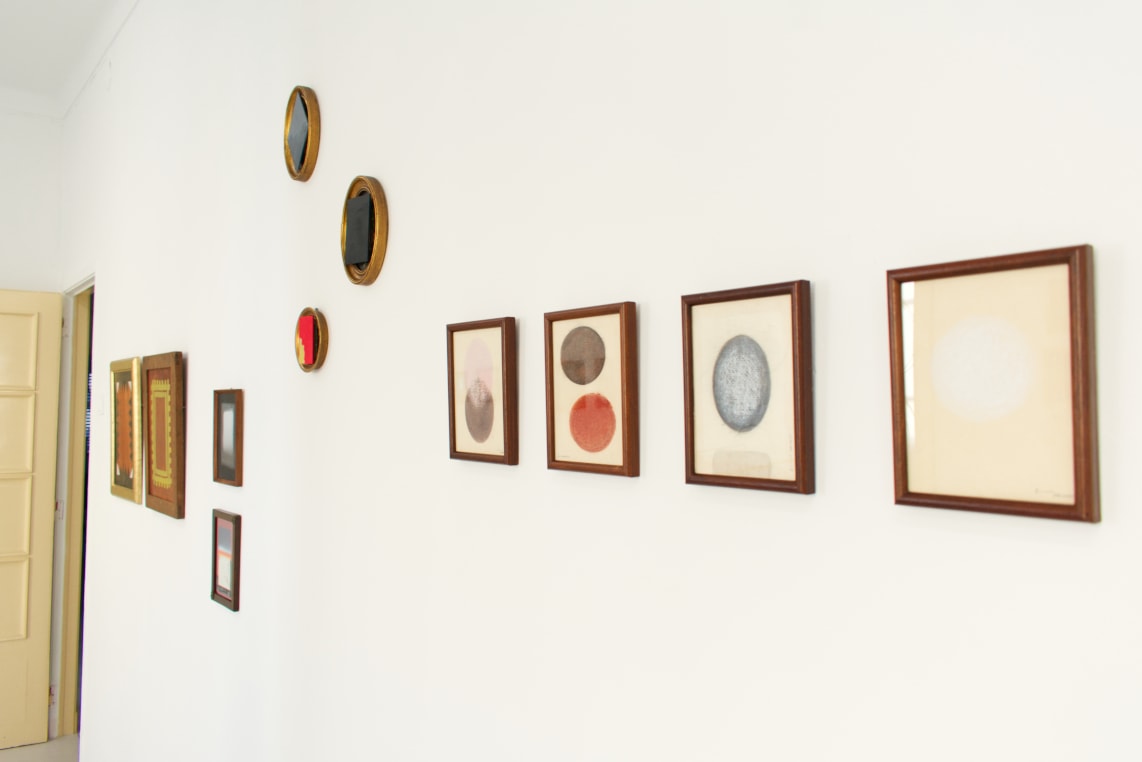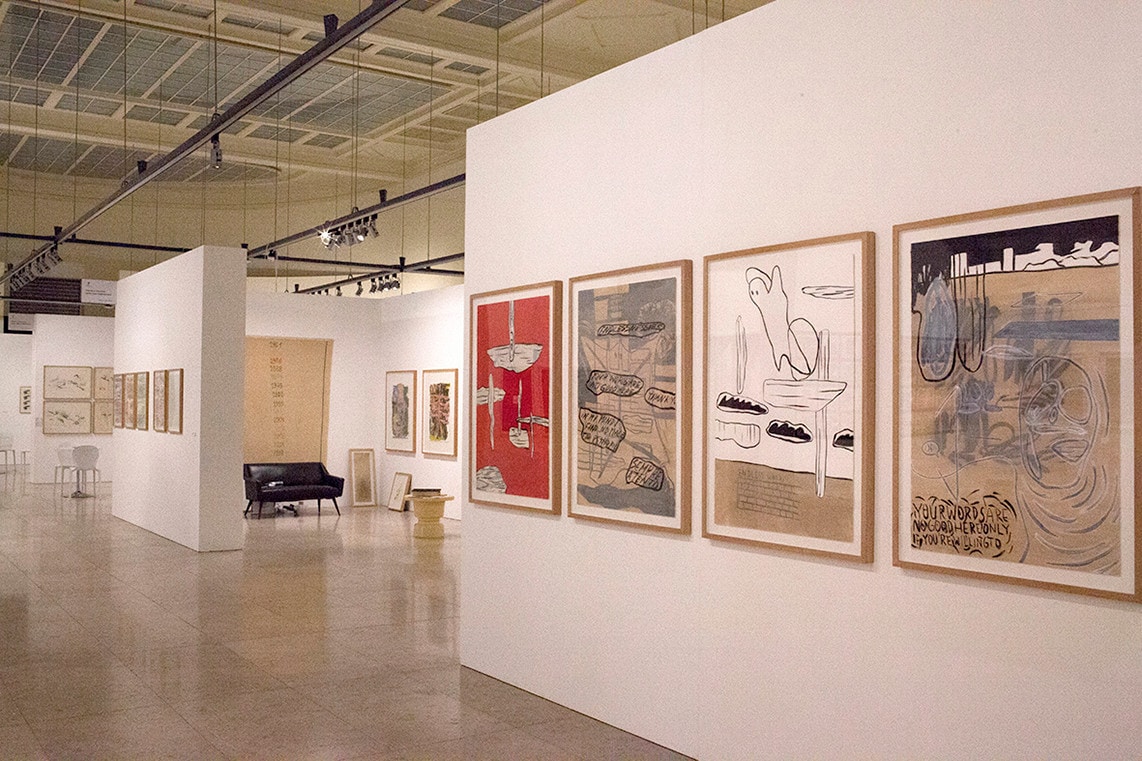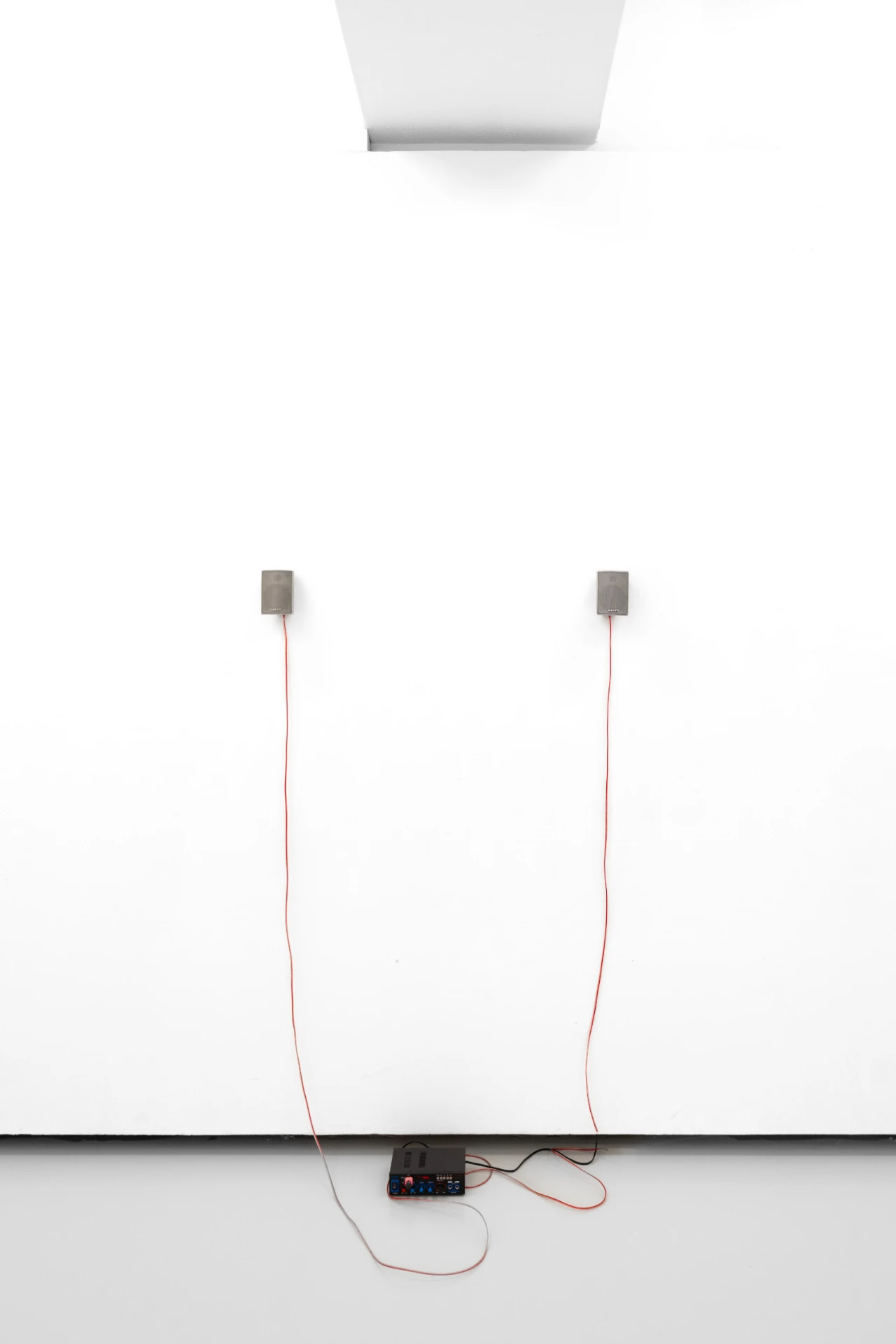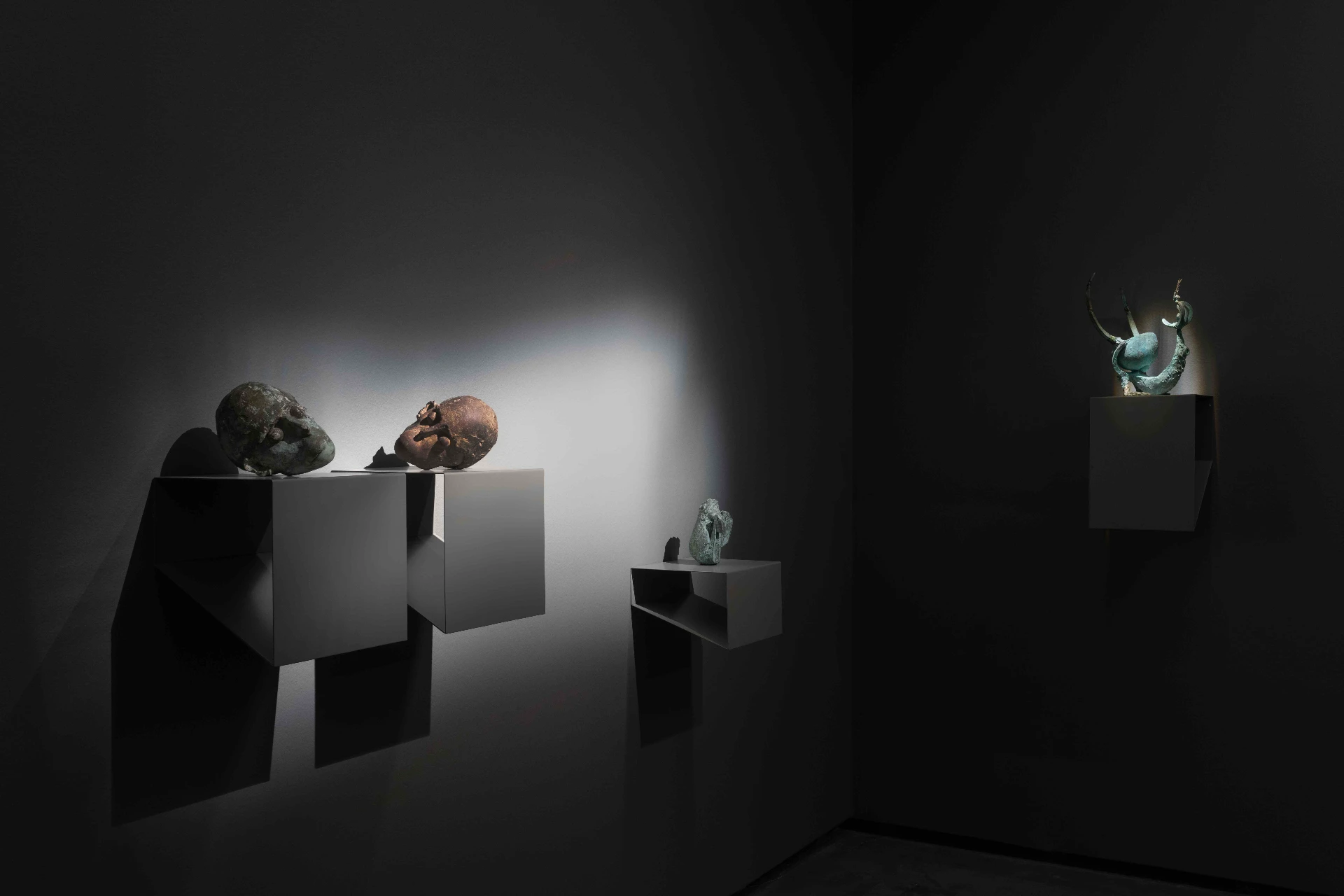Miguel Branco’s Blue Angel exhibition is entirely grouped on a single wall to the left of the gallery. A series of paintings on small wooden supports – the measurements are never identical -, some of which are square and others circular, punctuates the white stretch of wall like a map or constellation. The effect immediately produced is twofold: firstly, we realise the emptiness of the inhabited space and, secondly, the miniature forms appeal, from a distance – similar to the viewer’s own experience – to an approach. The restraint of the small scale is joined, in no less importance or emphasis, by the audacity of bringing together icons taken from the history of painting in very small frames, as Bernardo Pinto de Almeida writes on the exhibition text, drawing on an excerpt from the essay he signed for the catalogue of the artist’s previous exhibition: “Miguel Branco works (…) on images culled from that never-ending source we call (…) ‘the history of painting’ which, in truth, reaps ready-mades from the extensive pool of images into which the history of art itself has become”[1]. By using imagery taken from Christian religious iconography, as well as the Flemish and medieval traditions, the artist makes his work into an endless lab, in which the paintings no longer comply with the codes of the iconographic narratives, to which they are related by affinity, rather than with the desire and drive to re-elaborate them. Miguel Branco, in fact, encourages a properly plastic and bodily effort – and its essential awareness – by appealing to an approaching movement, incisively aimed at the viewer-visitor of the exhibition, which never ceases to take place: the continuous experience of the viewer never stops, the exhibition never ends (in a continuous horizontal line along the wall) and, finally, the active inclination of the act of looking never comes to an end. What, after all, is tradition, history and memory if not the present (and the presentification) of a permanent retreat (or an advance against the grain)?
As Freud suggested, the tiny tablets prompt us to carry out an exercise in free association – heresomething outside the therapeutic realm in which the father of psychoanalysis developed it – and, moreover, they force us to do so: they are images of the past, of different Western traditions, likely constitutive tangents of each person’s private history (at least around this corner of the globe), the spectrality of which provides the grammar and the terrain on which the future, as a projection, is built. Interestingly – and this is one of the exhibition’s most striking and distinctive traits -, the paintings we see along the wall seem to have been taken from another universe, yet are bereft of the aura that citation so often carries in itself, in a more or less tolerable virtuosity. They are therefore like scraps from a larger work, a sign of a pre-constellar, pre-figurative moment concerning thatconstellation and that figuration that we are now witnessing. A bit like the dreamlike unconscious, which, perhaps, the only way to dialogue, delve deeper and understand resides in this game of free association, which is first and foremost image-based. The figures are wrapped in a dramatic skin that recognises them as equal parts of a pre-linguistic chaos, enduring the appeal of meaning that, under the terms in which the paintings are displayed, is available as an invitation to assemble and/or fit together. This chaos can be translated on different scales, from the paintings to the psychic and thinking realm of each viewer: from mnesic impressions that we cannot locate in time, acquiring the brilliance of an impressionist landscape, more tonal than properly cropped, to the exemplary imagery of myths, and even to the maiden night of our conception (as individuals and as a species), a resounding enigma to which we always return. Either way, the convergence of motifs and iconographic figures on Miguel Branco’s tablets prompts a recalibration and contextualisation of our place and legacy as spectators. The artist teaches us that the birth of myths, as an achronic event, makes such chaos – the closest thing to a state of purity, prior to language and the universe itself – only conceivable in a subsequent time, only witnessable in a hidden and erratic posterity. If the presence of iconographic figures with mythological value sends the viewer back to a time before themselves, a matrix instance whose founding power is proportional to its inapprehensible character, it does so by creating compositions with a certain (post)apocalyptic flavour: solo figures in deserted settings, paintings of flowers, rocks and mountains – the elements almost coldly isolated and detached – reminiscent of the still life model, or settings in which their residents appear to be condemned to remain in that place and to be faithful to the expression, more or less circus-like, more or less melancholic, that they have in painting. In a specific visual economy, narrowly focused as a singular portion and life form, the paintings are scenes, performances, small pieces of travelling theatre, although stationary in the way they are presented, only mutable when they come into contact with an outside, an exterior. The paintings as small badges, portable enigmas, made of a material – wood – that Barthes said in Mythologies was welcoming to the touch, and this familiarity encourages the oddness that certain figures eminently dictate: a game as infinite as it is spellbinding.
Besides the historical significance – in the mythological dimension that always comes with it – of the narratives evoked, through figures such as angels, gargoyles, skulls, etc., reproducing a certain worldview, there is also a problem of critical schism. Blue Angel is equally notable as a potential reflection on the alienated sprawl in which we live today. Standing alone like pieces of a game without a fitting platform, of which the wooden supports are reminiscent, the exhibition deals with the problem, rather than the myths, of the figure and the value of myth, positioning it as a point of resistance in a grey, border area, to which the visual flashing of the paintings against the whiteness of the wall adds a texture and another readability. Mythological expressions are reborn through an associative stimulus that lends an unusual brightness to a story, to an archetypal image. Meanwhile, if this scattering can be the fine exposure of a structuring epochal distancing, a symptom of the ailments of civilisation – and the artist emerges here, in Baroque style, as the interpreter of the times, through a cleverly crafted dramatism -, it would be no less accurate to read such a centrifugal force as a way of reconnecting with ourselves, through icons, poignant due to the intricacy of detail, as opposed to the religious experience of the contrite worshipper in front of massive altars in their verticality, carved in gold or forged in marble.
Blue Angel is also a visual proposal on how to overcome oblivion and, as a result, how to generate new similarities, without a role model who, in the terms of Christian doctrine, would be the figurehead for man and all other beings. However, this is not to say that Miguel Branco is working at odds with the myths. Quite the opposite, he is praising myth, narrative and symbol. Either a eulogy or an elegy, since the softness, at times subtle, at others resolute in its promises of fluorescence – but lacking the light projector to grant it – imbues the paintings with the inkling that they are hints of a time that has passed and that we are, then, facing a life after life, inhabiting a world whose (new) language must be learnt, as well as mourned in another way.
If the word angel, in its etymology (from the Greek ággelos), points to the term of the messenger, the one who carries God’s message, using the colour blue as an adjective inscribes a double reference to the celestial dimension. The Angel who brings the message, from God to Man, the message proving to be the mark of a schism – a caesura – in which expression is achieved. A message from the Angel who bears within himself the colour of the sky through which he is moving: an active messenger whose colourful, visual journey takes precedence over any higher instance: this is the ultimate risk, the most up-to-date criticism. The language and life of the images can now only be found on the side of the statues that are waking up, the placid beings that are rising in flight and the strangers who, together, are meditating under the same sky, leaping from one tablet to another: “Nous jouissons de tout” (as written in one of the paintings) all the way to the stunned face in front of these postcards, this unfinished game, as enduring and as dazzling as it is untranslatable. The Angel, if he is not keeping everything, is looking back at us. And he is Blue – it is said.
Blue Angel by Miguel Branco is at Galeria Pedro Cera until November 4.
[1] Almeida, Bernardo Pinto (2023). Miguel Branco, Terra – ou os quarenta e nove degraus. Lisbon: Documenta, p.16.





